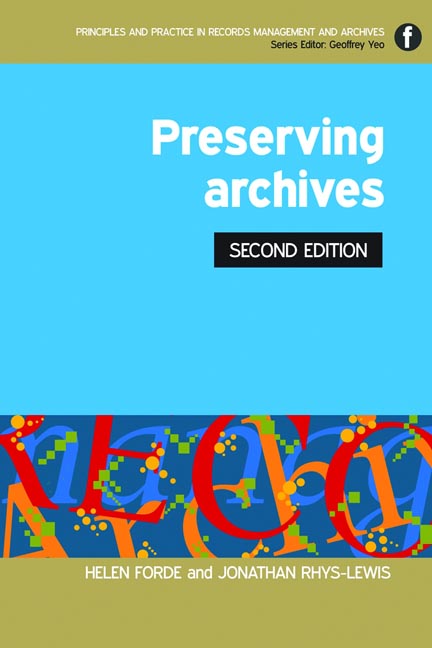Book contents
- Frontmatter
- Contents
- Introduction to the series Geoffrey Yeo
- Preface to the Second Edition
- Acknowledgements
- 1 Introducing archive preservation
- 2 Understanding archival materials and their characteristics
- 3 Managing digital preservation
- 4 Archive buildings and their characteristics
- 5 Safeguarding the building and its contents
- 6 Managing archival storage
- 7 Managing risks and avoiding disaster
- 8 Creating and using surrogates
- 9 Moving the records
- 10 Exhibiting archives
- 11 Handling the records
- 12 Managing a pest control programme
- 13 Training and the use of volunteers
- 14 Putting preservation into practice
- Appendices
- Bibliography
- British and international standards relating to archive preservation
- Index
1 - Introducing archive preservation
Published online by Cambridge University Press: 09 June 2018
- Frontmatter
- Contents
- Introduction to the series Geoffrey Yeo
- Preface to the Second Edition
- Acknowledgements
- 1 Introducing archive preservation
- 2 Understanding archival materials and their characteristics
- 3 Managing digital preservation
- 4 Archive buildings and their characteristics
- 5 Safeguarding the building and its contents
- 6 Managing archival storage
- 7 Managing risks and avoiding disaster
- 8 Creating and using surrogates
- 9 Moving the records
- 10 Exhibiting archives
- 11 Handling the records
- 12 Managing a pest control programme
- 13 Training and the use of volunteers
- 14 Putting preservation into practice
- Appendices
- Bibliography
- British and international standards relating to archive preservation
- Index
Summary
Introduction
Preservation of archives is the means by which the survival of selected material is ensured for enduring access. Perceptions that archivists preserved materials just for the sake of it are out of date and incorrect, if indeed they were ever correct; preservation and access are two parts of the same mission. Without sustained preservation activity it would not be possible to satisfy the myriad of users worldwide who beat a path to the door of archives and record offices, or who search for information on the web. Using archives has become a popular pastime for young and old, whether they are researching family history, requesting information under Freedom of Information Acts or pursuing historical facts. This increasing trend is unlikely to reverse and more than ever organizations must ensure that the material will be available, not only to the current generation but also to those of the future. Organizations must, as a matter of policy, look beyond their immediate requirements and utilize strategies and techniques to ensure that the originals, or if that is impossible the information contained in them, will be available for as long as needed. This book is designed to give readers the tools to manage preservation issues; it is not a manual on how to cope with every eventuality as these differ widely and advice for one archive might be quite inappropriate for another. Alongside this is the key intention; to act as a lead and guide for the varying needs, questions and research of fellow professionals charged with the responsibility of preservation.
How has the relationship between conservation and
preservation developed?
Once, looking after documents was within the remit of all curatorial members of staff, many of whom no doubt undertook basic repairs to the best of their rather limited ability. In the 1950s and 1960s archive conservation began to develop as a distinct skill – one which, given their increasing responsibilities in other directions, curators were happy to cede to conservators. At that time conservation was a wide-reaching term embracing many aspects of what is now included under the umbrella of preservation. Since then, those employed as archive conservators have become specialists in the intervention techniques required to stabilize badly damaged material.
- Type
- Chapter
- Information
- Preserving Archives , pp. 1 - 4Publisher: FacetPrint publication year: 2013



